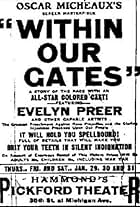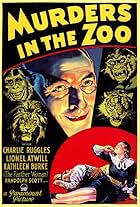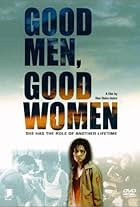Racists learn that the land a negro owns lies over a vast oil field, and threaten his life when he refuses to sell.Racists learn that the land a negro owns lies over a vast oil field, and threaten his life when he refuses to sell.Racists learn that the land a negro owns lies over a vast oil field, and threaten his life when he refuses to sell.
Louis Dean
- August Barr
- (as Louis Déan)
Edward Fraction
- Peter Kaden
- (uncredited)
Edward E. King
- Tom Cutschawl
- (uncredited)
Lena L. Loach
- Christina
- (uncredited)
- Director
- Writer
- All cast & crew
- Production, box office & more at IMDbPro
Storyline
Did you know
- TriviaThe only surviving print of this film is in the collection of the Cinematheque Royale in Belgium. Its title cards are in French and Flemish. They have been translated back, from French, into English.
- Quotes
Title Card: Jefferson Dirscoll, one of the many mulattos who conceal their origins. Since that cursed moment in which his mother had involuntarily betrayed the secret of this race. Driscoll had developed a ferocious hatred for the black race, from which he was born.
- ConnectionsFeatured in American Experience: Midnight Ramble (1994)
Featured review
After "Within Our Gates" (1920), the second of Oscar Micheaux's three surviving silent films (that I know of as of this writing), "The Symbol of the Unconquered" is another, along with the prior picture, strong rebuttal to D.W. Griffith's "The Birth of a Nation" (1915), as well as a reflection of the Great Migration in the United States and a revision of the melodrama and Western genres. Griffith's ahistorical and racist Civil War and Reconstruction-era epic is probably the most influential film ever made, including being largely responsible for the creation of the second KKK. It also galvanized African Americans into action, including the then-nascent NAACP, which protested the film, and Micheaux, who took to filmmaking to correct such screen misrepresentations of race, sex, and the Klan. Not the heroes Griffith depicted, the night riders are terrorists behind a system of corruption and racism.
Unfortunately, little more than half of the original film appears to exist now, including the surviving print missing its climax and with the restoration only providing a brief synopsis from a contemporary review to give us an idea of what happened in it. We see what leads up to and what the resolution is of the attack from the Klan on a black prospector in an effort to steal his land, but we're missing the confrontation itself. It makes it difficult to evaluate the picture aesthetically, without the payoff, just as the heightened crosscutting was escalating the tension--contrasting torch-lit nighttime cinematography of the Klan with daytime (and perhaps originally tinted day-for-night) images of the female heroine mounting her own horse to organize a rescue effort for her prospector neighbor. The anti-racist intent of racial uplift of the film remains clear, though, and given the financial and technical limitations (the day lighting of some of the supposed night scenes here in particular) accessible to the African-American filmmaker Micheaux, the extreme censorship and other difficulties in distribution his films faced and the fact of the poor treatment of nitrate prints for most of the afterlife of the silent film era, it's fortunate the much of the film still exists at all. Most of his silent films--most silent films in general--don't.
In addition to recasting the Klan as the villainous and multi-racial "Knights of the Black Cross," Micheaux also focuses a lot on relations between lighter and darker-skinned African Americans. The dilemma of the central romance hinges on the man not knowing that the woman he loves is also black and her not knowing that she's sometimes "passing" as white. "The melodramatic trope of someone being other than what he or she seems," as Pearl Bowser and Louise Spence put it in their essay "Oscar Micheaux's The Symbol of the Unconquered: Text and Context," and given that melodrama was the genre both Griffith and Micheaux tended to work in, the effectiveness of the melodrama (as Dan Florey begins to get at in the essay "Race, Rationality, and Melodrama: Aesthetic Response and the Case of Oscar Micheaux") was paramount to Micheaux's recasting of the cinematic representation of race, sex, or the Klan.
Additionally, the Western genre plays interestingly into the Great Migration narrative of the film, which is set in the Northwest, the heroine having moved their from the South to inherit her grandfather's land. The prospector hero, Van Allen, is ruggedly self-sufficient and courteous to a good woman as typical of Western heroes. Adding to the racial difference from mainstream entries in the genre, it's the heroine, Eve Mason, dressed in full cowgirl regalia and riding a horse as it bucks, who comes to rescue the man as his property is threatened by unscrupulous bandits.
Perhaps even more intriguing, the main villain hates his own race, including his black mother, who once ruined his courtship of a white woman by her presence exposing his racial heritage, as he intentionally tries to cross the color line. That Lawrence Chenault portrays such a complicated antagonist makes "The Symbol of the Unconquered" all the more compelling. This reconfiguration of the "mulatto" characters, the good woman and the bad man, is in stark contrast to Griffith's simplistic and racist depiction of their villainy as an innate consequence of miscegenation. It's the locus of Griffith's racial and sexual paranoia, of black men having sex (but always considered rape by Griffith and his ilk) with white women. For Micheaux's mulatto, it's also sexual, but may be a consequence of the interracial relationship being denied rather than the other way around. That the role of Chenault's Driscoll's mother is cast as the proof of his race and, perhaps, a suggestion of the history of white men raping black women also hints at this reversal of Griffith's characterization. Micheaux, after all, did much the same in the more-complete extant print of "Within Our Gates." Another great scene here of Driscoll forced to confront his own race occurs in a through-the-mirror shot as he sees the proudly black Van Allen behind him before they fight over stolen horses.
J. Ronald Green (in the book "With a Crooked Stick -- The Films of Oscar Micheaux") also points out that the early scene of Eve's escape into a storm as recalling Lillian Gish in Griffith's "Way Down East" (1920). Although now an incomplete film, what remains of "The Symbol of the Unconquered"--its use of melodrama and the Western to counteract Griffith's cinematic misrepresentations, to portray good and evil as not based on race, heroes and those to be rescued as not based on sex, and to offer positive portrayals of race men and women for social uplift--is enough to prove its greatness beside Micheaux's two other surviving silent films, "Within Our Gates" and "Body and Soul" (1925).
Unfortunately, little more than half of the original film appears to exist now, including the surviving print missing its climax and with the restoration only providing a brief synopsis from a contemporary review to give us an idea of what happened in it. We see what leads up to and what the resolution is of the attack from the Klan on a black prospector in an effort to steal his land, but we're missing the confrontation itself. It makes it difficult to evaluate the picture aesthetically, without the payoff, just as the heightened crosscutting was escalating the tension--contrasting torch-lit nighttime cinematography of the Klan with daytime (and perhaps originally tinted day-for-night) images of the female heroine mounting her own horse to organize a rescue effort for her prospector neighbor. The anti-racist intent of racial uplift of the film remains clear, though, and given the financial and technical limitations (the day lighting of some of the supposed night scenes here in particular) accessible to the African-American filmmaker Micheaux, the extreme censorship and other difficulties in distribution his films faced and the fact of the poor treatment of nitrate prints for most of the afterlife of the silent film era, it's fortunate the much of the film still exists at all. Most of his silent films--most silent films in general--don't.
In addition to recasting the Klan as the villainous and multi-racial "Knights of the Black Cross," Micheaux also focuses a lot on relations between lighter and darker-skinned African Americans. The dilemma of the central romance hinges on the man not knowing that the woman he loves is also black and her not knowing that she's sometimes "passing" as white. "The melodramatic trope of someone being other than what he or she seems," as Pearl Bowser and Louise Spence put it in their essay "Oscar Micheaux's The Symbol of the Unconquered: Text and Context," and given that melodrama was the genre both Griffith and Micheaux tended to work in, the effectiveness of the melodrama (as Dan Florey begins to get at in the essay "Race, Rationality, and Melodrama: Aesthetic Response and the Case of Oscar Micheaux") was paramount to Micheaux's recasting of the cinematic representation of race, sex, or the Klan.
Additionally, the Western genre plays interestingly into the Great Migration narrative of the film, which is set in the Northwest, the heroine having moved their from the South to inherit her grandfather's land. The prospector hero, Van Allen, is ruggedly self-sufficient and courteous to a good woman as typical of Western heroes. Adding to the racial difference from mainstream entries in the genre, it's the heroine, Eve Mason, dressed in full cowgirl regalia and riding a horse as it bucks, who comes to rescue the man as his property is threatened by unscrupulous bandits.
Perhaps even more intriguing, the main villain hates his own race, including his black mother, who once ruined his courtship of a white woman by her presence exposing his racial heritage, as he intentionally tries to cross the color line. That Lawrence Chenault portrays such a complicated antagonist makes "The Symbol of the Unconquered" all the more compelling. This reconfiguration of the "mulatto" characters, the good woman and the bad man, is in stark contrast to Griffith's simplistic and racist depiction of their villainy as an innate consequence of miscegenation. It's the locus of Griffith's racial and sexual paranoia, of black men having sex (but always considered rape by Griffith and his ilk) with white women. For Micheaux's mulatto, it's also sexual, but may be a consequence of the interracial relationship being denied rather than the other way around. That the role of Chenault's Driscoll's mother is cast as the proof of his race and, perhaps, a suggestion of the history of white men raping black women also hints at this reversal of Griffith's characterization. Micheaux, after all, did much the same in the more-complete extant print of "Within Our Gates." Another great scene here of Driscoll forced to confront his own race occurs in a through-the-mirror shot as he sees the proudly black Van Allen behind him before they fight over stolen horses.
J. Ronald Green (in the book "With a Crooked Stick -- The Films of Oscar Micheaux") also points out that the early scene of Eve's escape into a storm as recalling Lillian Gish in Griffith's "Way Down East" (1920). Although now an incomplete film, what remains of "The Symbol of the Unconquered"--its use of melodrama and the Western to counteract Griffith's cinematic misrepresentations, to portray good and evil as not based on race, heroes and those to be rescued as not based on sex, and to offer positive portrayals of race men and women for social uplift--is enough to prove its greatness beside Micheaux's two other surviving silent films, "Within Our Gates" and "Body and Soul" (1925).
- Cineanalyst
- Mar 2, 2021
- Permalink
Details
- Release date
- Country of origin
- Language
- Also known as
- The Symbol of the Unconquered: A Story of the Ku Klux Klan
- Filming locations
- Production company
- See more company credits at IMDbPro
- Runtime54 minutes
- Color
- Sound mix
- Aspect ratio
- 1.33 : 1
Contribute to this page
Suggest an edit or add missing content

Top Gap
By what name was The Symbol of the Unconquered (1920) officially released in Canada in English?
Answer

















